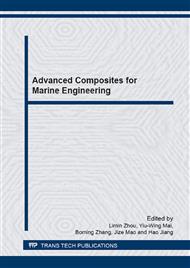p.188
p.194
p.202
p.210
p.220
p.243
p.250
p.258
p.265
Influence of Core Splice to the Mechanical Behavior of Sandwich Plate
Abstract:
The cores have to be spliced in the manufacturing process of sandwich plate due to the processing technology, the influence of core splice, compared with integrated core, on mechanical behavior of sandwich plate were investigated through two experiments. Two styles of specimens (B-style and C-style) were taken into experiments in sequence which included two kinds of plate with different cores.Firstly, it was found in stiffness experiment that stiffness and strength of sandwich plate with splicing core were obviously weaker than that with integrated core, which mean the former performed larger deformation under the same predetermined load with higher strain and behaved lower ultimate bearing capacity. Meanwhile the failure modes were mainly sheet crushing collapse and there was no evident difference in the failure mode of the two styles specimens with different cores. It concluded that the cores splice reduced the stiffness in location of two core splicing but the effect on the failure mode was slight.Secondly, it was found in stability experiment that the mechanical behaviour was approximately linear under the predetermined axial load and the predetermined out-of-plane load and similarly bulking strength of the sandwich plate with splicing core was about 10%~15% lower than that with integrated core. Basically, delamination between sheet and core kept accompany with bulking of the plate each time and two styles specimens with different cores didn’t show evident differences in failure mode as well. It demonstrated the conclusion and that core splice accounted to make the specimens produced geometric imperfections which resulted in stiffness reduction.Thirdly, based on experiments it was clear that the mechanical behaviour of sandwich plates with splicing cores suffered from more obvious discreteness compared with that with integrated cores, which indicated that manufacturing technology had greater influence on the former and core splice should be avoided in some important location of structure.Lastly, numerical simulation method based on progressive damage analysis was also studied and good correlation with experimental results was obtained, which could well predict the mechanical behaviour of the sandwich plates with splicing core and integrated core.
Info:
Periodical:
Pages:
220-239
Citation:
Online since:
March 2015
Authors:
Price:
Сopyright:
© 2015 Trans Tech Publications Ltd. All Rights Reserved
Share:
Citation:


